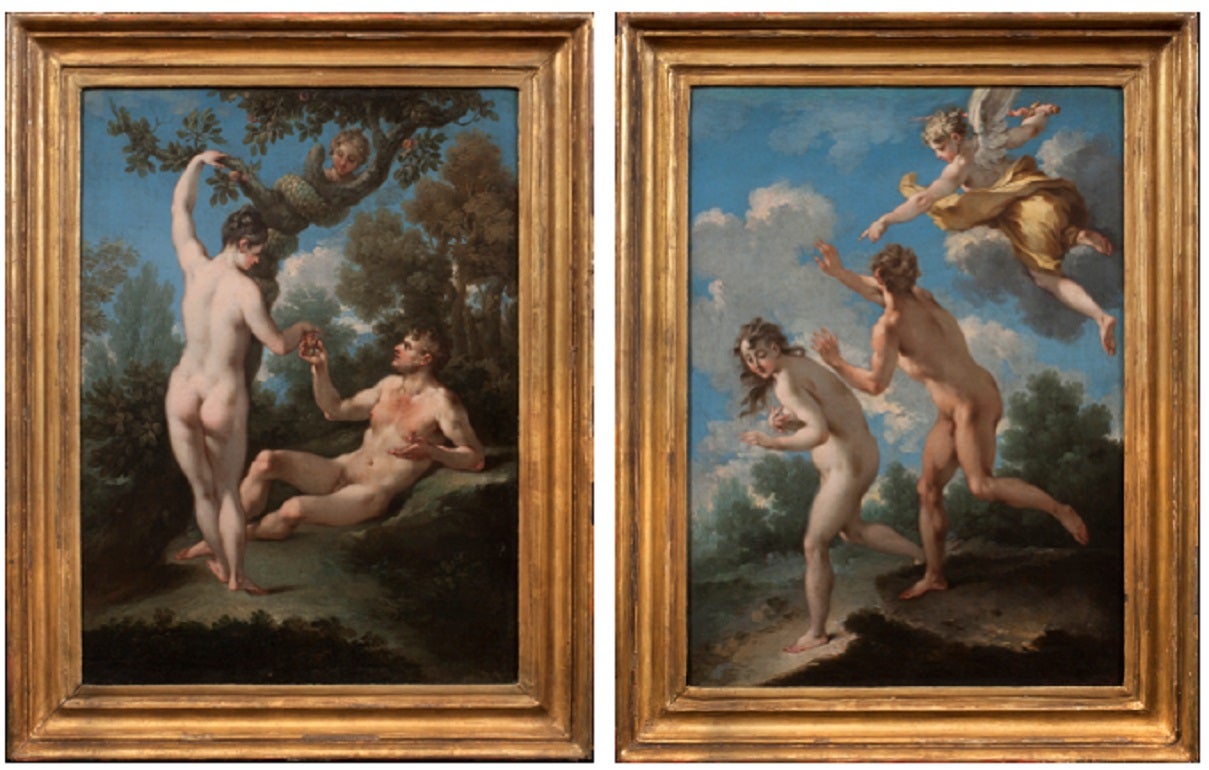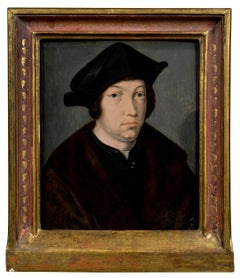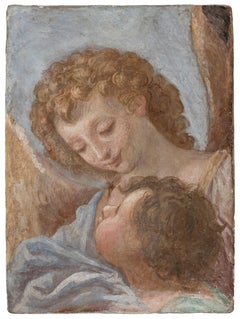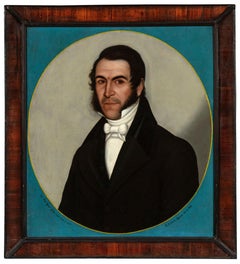Want more images or videos?
Request additional images or videos from the seller
1 of 6
UnknownPortrait of a Gentleman
Price:$20,000
$45,000List Price
About the Item
- Dimensions:Height: 17.125 in (43.5 cm)Width: 13.75 in (34.93 cm)
- Medium:
- Movement & Style:
- Period:
- Condition:
- Gallery Location:New York, NY
- Reference Number:1stDibs: G12052410214

About the Seller
5.0
Recognized Seller
These prestigious sellers are industry leaders and represent the highest echelon for item quality and design.
Established in 1997
1stDibs seller since 2012
24 sales on 1stDibs
Typical response time: 9 hours
Authenticity Guarantee
In the unlikely event there’s an issue with an item’s authenticity, contact us within 1 year for a full refund. DetailsMoney-Back Guarantee
If your item is not as described, is damaged in transit, or does not arrive, contact us within 7 days for a full refund. Details24-Hour Cancellation
You have a 24-hour grace period in which to reconsider your purchase, with no questions asked.Vetted Professional Sellers
Our world-class sellers must adhere to strict standards for service and quality, maintaining the integrity of our listings.Price-Match Guarantee
If you find that a seller listed the same item for a lower price elsewhere, we’ll match it.Trusted Global Delivery
Our best-in-class carrier network provides specialized shipping options worldwide, including custom delivery.You May Also Like
Male and female portrait, both in silk kimono, possibly textile dealers
By Christoffel Lubieniecki
Located in Amsterdam, NL
CHRISTOFFEL LUBIENIECKI (1659-1729)
Pair of portraits of a gentleman and a lady, both in silk kimono, before a country house (circa 1680)
Indistinctly signed “C.......” on a box under the man’s left hand
Oil on canvas, 79.5 x 67 cm each
Both sitters are portrayed wearing a silk “Japanese” coat. During the second half of the seventeenth the Japanese silk coat, an adapted Japanese kimono, became a real vogue in the Dutch elite. The exclusive Dutch trade contacts with Japan can explain the popularity of the kimono-style silk coats in the Netherlands. Everybody who could afford one, dressed in such a fashionable and comfortable coat and, like the present sitters, some proud owners had themselves portrayed in a “Japanese” coat often together with an oriental carpet to underline their standing and international connections. These portraits are the work of the Polish-born portraitist Christoffel Lubieniecki (also known as Lubienitski, Lubinitski or Lubiniecki)
Lubieniecki was first trained in Hamburg under Julian Stuhr and after 1675 in Amsterdam under Adriaen Backer and Gerard de Lairesse. He specialized in landscapes, generally of an Italianate character, and in portraits. The loving execution of these contented burghers, enjoying the garden vistas of their country house, places him alongside Amsterdam portraitists such as Constantijn Netscher and Michiel van Musscher...
Category
1680s Old Masters Portrait Paintings
Materials
Canvas, Oil
$37,999
Free Shipping
H 31.34 in W 26.38 in D 1.97 in
18th Century by Antonio Mercurio Amorosi Portrait Little Girl with Cat
By Antonio Mercurio Amorosi
Located in Milano, Lombardia
Artist: Antonio Mercurio Amorosi (Comunanza, Italy, 1660 - 1738)
Title: Portrait of a little girl with cat
Medium: Oil on canvas
Dimensions: without frame 42 x 31.5 cm – with frame 5...
Category
Early 18th Century Old Masters Portrait Paintings
Materials
Canvas, Oil
$16,909 Sale Price
23% Off
H 16.54 in W 12.41 in D 1.97 in
17th Century by Bernardo Strozzi Portrait of a man with white collar
By Bernardo Strozzi
Located in Milano, Lombardia
Bernardo Strozzi, also known as “Il Cappuccino” and “il Prete Genovese”, (Genoa, Italy, 1581 – Venice, Italy, 1644)
Title: Portrait of a man with white collar
Medium: Oil on canvas
D...
Category
17th Century Old Masters Portrait Paintings
Materials
Canvas, Oil
$63,082 Sale Price
20% Off
H 25.2 in W 18.12 in
17th Century by Giuseppe Assereto Portrait of an Elderly Woman Oil on Canvas
By Giuseppe Assereto
Located in Milano, Lombardia
Giuseppe Assereto (Genova - 1626 ca – Genova 1656/57)
Title: Portrait of an elderly woman, possible portrait of Maddalena Massone, wife of Gioacchino Assereto
Medium: Oil on canvas
D...
Category
Early 17th Century Old Masters Portrait Paintings
Materials
Oil, Canvas
$36,954 Sale Price
21% Off
H 25.79 in W 20.28 in D 1.97 in
17th-18th Century By Niccolò Cassana Portrait of a Gentleman Oil on Canvas
Located in Milano, Lombardia
Niccolò Cassana (Venice, Italy, 1659 - London, UK, 1714)
Title: Portrait of a Gentleman
Medium: Oil on canvas
Dimensions: without frame 119.5 x 92.5 cm
Painting without frame.
Expe...
Category
17th Century Old Masters Portrait Paintings
Materials
Oil, Canvas
$20,044 Sale Price
20% Off
H 47.05 in W 36.42 in D 1.97 in
18th Century By Dalla Rosa Portrait of Angela Guggerotti Fracastoro Oil/Canvas
Located in Milano, Lombardia
Saverio Dalla Rosa (Verona, Italy, 1745 - 1821)
Title: Portrait of Angela Guggerotti Fracastoro
Medium: Oil on canvas
Dimensions: without frame 94 x 73 cm - with frame 105 x 94 cm
Fr...
Category
18th Century Old Masters Portrait Paintings
Materials
Canvas, Oil
$18,999 Sale Price
20% Off
H 37.01 in W 28.75 in D 1.97 in
French School of the 17th Century Female portrait with flowers Oil on canvas
Located in Milano, Lombardia
French School of the 17th Century – Circle of Pierre Mignard (1612-1695)
Title: Female portrait with flowers
Medium: Oil on canvas
Dimensions: without frame 81 × 68 cm – with frame ...
Category
17th Century Old Masters Portrait Paintings
Materials
Canvas, Oil
$16,909 Sale Price
20% Off
H 31.89 in W 26.78 in
17th Century by Pedro Nunez Portrait of a Child Oil on Canvas
Located in Milano, Lombardia
Pedro Nuñez de Villavicendio (Seville, Spain, 1644 - 1700)
Title: Portrait of a child
Medium: Oil on canvas
Dimensions: without frame 41.5 x 33.5 cm - with frame 52 x 43.5 cm
19th century shaped and gilded wooden frame
Expertise by Didier Bodart, art historian
A Seville painter of noble origins, Pedro Nuñez de Villavicendio (1644-1700), the author of this pretty child portrait, was a Knight of the Order of St John of Jerusalem. He was a pupil of Murillo and, as a Knight of the Order of Malta, worked with Mattia Preti...
Category
Late 17th Century Old Masters Portrait Paintings
Materials
Cotton Canvas, Canvas, Oil
$12,729 Sale Price
23% Off
H 16.15 in W 13.19 in D 1.97 in
19th Century By Giuseppe Molteni Portrait of a Woman Oil on Canvas
Located in Milano, Lombardia
Giuseppe Molteni (Affori (Milano), Italy, 1800 - Milano, Italy, 1867)
Title: Portrait of a Woman
Medium: Oil on canvas
Dimensions: without frame 67 × 55 cm - with frame 91.5 x 80 cm
...
Category
19th Century Old Masters Portrait Paintings
Materials
Oil, Canvas
$26,197 Sale Price
20% Off
H 26.38 in W 21.66 in D 1.97 in
17th Century by Andrea Vaccaro Penitent Magdalene Oil on canvas
Located in Milano, Lombardia
Andrea Vaccaro (Naples, Italy, 1604 – 1670)
Title: Penitent Magdalene
Year: 1630-1635 ca.
Medium: Oil on canvas
Dimensions: without frame 75 x 62 cm – with frame 87.5 x 74.7 x 5.5 cm...
Category
17th Century Old Masters Portrait Paintings
Materials
Canvas, Oil
$55,953 Sale Price
20% Off
H 29.53 in W 24.41 in
More From This Seller
View AllPortrait of a Man
Located in New York, NY
Provenance:
with Leo Blumenreich and Julius Böhler, Munich, 1924
Dr. Frederic Goldstein Oppenheimer (1881-1963), San Antonio, Texas; by whom given to:
Abraham M. Adler, New York, until 1985; thence by descent to the present owners
While old inscriptions on the verso of this panel propose its author to be Hans Holbein and the sitter Sir John More—a lawyer, judge, and the father of Sir Thomas More—this fine portrait has long been recognized to be by a Flemish hand. Max Friedländer gave the painting to Bernard van Orley (1487/1491 – 1541) in 1924, but did not include it in the volume dedicated to the artist in his Early Netherlandish Paintings...
Category
16th Century Old Masters Portrait Paintings
Materials
Oil, Panel
$52,500
A Guardian Angel and a Child
Located in New York, NY
Provenance:
Cornelius Vanderbilt, New York; by whom gifted in 1880 to:
The Metropolitan Museum of Art, New York (80.3.673); deaccessioned and sold:
Christie’s, New York, 12 June 19...
Category
17th Century Old Masters Portrait Paintings
Materials
Terracotta, Gesso
Portrait of Dr. Juan Ignacio Galves
Located in New York, NY
Signed and dated, along the bottom of the oval:
Dõr. Juan Ygnacio Galves nació el año de 1797. / Por J. Celestino Figueroa año de 1841.
Provenance: Luis Alberto Acuña (1904–1994), ...
Category
1840s Portrait Paintings
Materials
Canvas, Oil
Head of a Classical Poet (Socrates?)
By Pier Francesco Mola
Located in New York, NY
Provenance:
Possibly Antonio Amici Moretti, Rome, 1690
Roy Clyde Gardner, Union, Mississippi, 1970s until 2004; by whom given to:
Mississippi Band of Choctaw Indians, 2004-2010
Lit...
Category
17th Century Baroque Paintings
Materials
Canvas, Oil
Portrait of George and Edward Finch-Hatton in Van Dyck Dress
By David Martin
Located in New York, NY
Appointed Portrait Painter to the Prince of Wales in Scotland in 1785, David Martin was the leading Scottish portrait painter of his generation. The artist is best known in the United States for his portrait of Benjamin Franklin, which is in the White House collection, Washington, D.C. The sitters depicted in this double portrait were the sons of the British diplomat Edward Finch-Hatton. George (1747-1823), later of Eastwell Park, Kent, is shown seated, reading an ancient charter or medieval manuscript...
Category
18th Century and Earlier Paintings
Materials
Canvas, Oil
Portrait of a Boy with a Squirrel
Located in New York, NY
Provenance: Lewis J. Ruskin, Arizona, 1958–1981; thence by descent to the present owner.
This charming portrait of a young boy with his pet squirrel is a newly-discovered work by G...
Category
Mid-19th Century Portrait Paintings
Materials
Canvas, Oil
Recently Viewed
View AllMore Ways To Browse
Theodore Gericault
Louis Gerard
Francois Gerard
Gaspare Landi
19th Century Portraits Of Women
Dutch Golden Age
Impressionist Oil Paintings Paris
Large English Landscape Oil Painting
Monochromatic Art
River Thames
Impressionist City
Rural Landscape Painting
Water Ripple
Desert Painting
Modern Original Oil Paintings
Oil Can
Oil Cans
Outsider Artist



